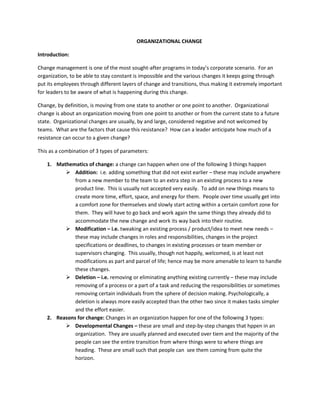
Organizational change
- 1. ORGANIZATIONAL CHANGE Introduction: Change management is one of the most sought-after programs in today’s corporate scenario. For an organization, to be able to stay constant is impossible and the various changes it keeps going through put its employees through different layers of change and transitions, thus making it extremely important for leaders to be aware of what is happening during this change. Change, by definition, is moving from one state to another or one point to another. Organizational change is about an organization moving from one point to another or from the current state to a future state. Organizational changes are usually, by and large, considered negative and not welcomed by teams. What are the factors that cause this resistance? How can a leader anticipate how much of a resistance can occur to a given change? This as a combination of 3 types of parameters: 1. Mathematics of change: a change can happen when one of the following 3 things happen Addition: i.e. adding something that did not exist earlier – these may include anywhere from a new member to the team to an extra step in an existing process to a new product line. This is usually not accepted very easily. To add on new things means to create more time, effort, space, and energy for them. People over time usually get into a comfort zone for themselves and slowly start acting within a certain comfort zone for them. They will have to go back and work again the same things they already did to accommodate the new change and work its way back into their routine. Modification – i.e. tweaking an existing process / product/idea to meet new needs – these may include changes in roles and responsibilities, changes in the project specifications or deadlines, to changes in existing processes or team member or supervisors changing. This usually, though not happily, welcomed, is at least not modifications as part and parcel of life; hence may be more amenable to learn to handle these changes. Deletion – i.e. removing or eliminating anything existing currently – these may include removing of a process or a part of a task and reducing the responsibilities or sometimes removing certain individuals from the sphere of decision making. Psychologically, a deletion is always more easily accepted than the other two since it makes tasks simpler and the effort easier. 2. Reasons for change: Changes in an organization happen for one of the following 3 types: Developmental Changes – these are small and step-by-step changes that hppen in an organization. They are usually planned and executed over tiem and the majority of the people can see the entire transition from where things were to where things are heading. These are small such that people can see them coming from quite the horizon.
- 2. Transitional Changes- these changes happen when there’s a negative state the organization lands into and needs to start moving towards a potentially positive future Transansitional changes, at the time they happen, become essential for the very survival of the organization sometimes. This change takes what is not working properly and converts into something that is going to be working properly over time. Organizations in crisis always need an effective transitional change to happen and employees will inevitably go through the same to grow and evolve positively. Team state of mind: irrespective of what the change is, the team or the employees are usually in either a more receptive state or in a declining state. Based on the overall mood of the team, the change can be one of the two following: Change Storm- Many times the change is rather unpleasant or it hits the team when there is an inherent unpleasantness involved within them. At such a time, any change from the ones mentioned above may not be welcomed at all and might be considered an intrusion. Change Breeze – When the team or the employees seem to be in a positive bent of mind, they may accept the change much more easily, and it just flits through the team and gets implemented. To make this happen, it is imperative for the team to be bonded and synergized together as well as for the organization to have constantly kept information transparent so that they are aware of the dynamics amongst themselves and the dynamics of the change too. Conclusion: Both developmental and transformational changes can be a change breeze or a change storm. Understand whether the team is in a state of breeze or a storm and whether the change is developmental or transformational and whether it is as a process, an addition or deletion or modification and take the change into the organization accordingly. Leverage responses to change… Make change happen effectively….
